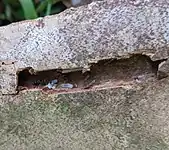Pseudomyrmex gracilis
Pseudomyrmex gracilis, also known as the graceful twig ant, Mexican twig ant, slender twig ant, or elongated twig ant, is a large, slender species native to Mexico and arid parts of the US. The workers are about 8–10 millimeters (0.31–0.39 in) in length and generally wasp-like in appearance and style of movement. Worker ants are bi-colored; the head and gaster are dark, while the antennae, mouthparts, thorax and legs are dull orange with dark shading. They often may be seen on vegetation, foraging for live insects or collecting honeydew from sap-sucking insects.[1]
| Pseudomyrmex gracilis | |
|---|---|
 | |
| Pseudomyrmex gracilis worker | |
| Scientific classification | |
| Domain: | Eukaryota |
| Kingdom: | Animalia |
| Phylum: | Arthropoda |
| Class: | Insecta |
| Order: | Hymenoptera |
| Family: | Formicidae |
| Genus: | Pseudomyrmex |
| Species: | P. gracilis |
| Binomial name | |
| Pseudomyrmex gracilis (Fabricius, 1804) | |
If the colony ever finds themselves without a queen, the worker ants form dominance hierarchies by boxing with their antennae. This leads to a couple high ranking individuals which can lay eggs until a new queen returns.
Images
 Colony chamber – shows multiple life stages of P. gracilis nesting in a Sabal palmetto frond
Colony chamber – shows multiple life stages of P. gracilis nesting in a Sabal palmetto frond
References
- "Pseudomyrmex gracilis (Fabricius) (Insecta: Hymenoptera: Formicidae: Pseudomyrmecinae)". Featured Creatures. University of Florida, Department of Entomology and Nematology. Retrieved 12 April 2020.
Further reading
- Volker S. Schmid; Martin Kaltenpoth; Erhard Strohm & Jürgen Heinze (2013) "Worker self-restraint and policing maintain the queen’s reproductive monopoly in a pseudomyrmecine ant pp. 1